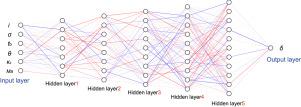利用深度学习提高轴向压缩机一维特性预测的准确性
IF 8
2区 计算机科学
Q1 AUTOMATION & CONTROL SYSTEMS
Engineering Applications of Artificial Intelligence
Pub Date : 2025-03-16
DOI:10.1016/j.engappai.2025.110533
引用次数: 0
摘要
为了提高多级轴流压气机一维特性预测的准确性,提高设计效率,本文利用计算流体力学(CFD)仿真数据,提出了一种基于深度学习的偏转角预测模型。将该模型集成到压缩机特性计算程序中。利用美国国家航空咨询委员会65系列(NACA65)叶片型线创建CFD模拟数据集,并通过拉丁超立方体设计进行参数化。求解叶片叶栅流场后,得到不同工况下的偏差角,利用深度学习建立设计变量与偏差角之间的映射关系。试验结果表明,相关系数为0.9978,平均绝对误差为0.0785°。将代理模型嵌入到轴流压气机1D计算程序(HARIKA)中,取代原有的偏差角模型。跨音速两级和高亚音速八级压气机在不同速度下的性能计算表明,更新后的HARIKA程序在高速下提供了更接近实验值的预测,尽管在低速下略有高估。这些结果验证了模型的准确性和实用性,表明改进的HARIKA算法在多级轴流压气机气动性能预测方面具有工程应用潜力。本文章由计算机程序翻译,如有差异,请以英文原文为准。

Enhancing accuracy of one-dimensional characteristic predictions for axial compressors using deep learning
To enhance the accuracy of one-dimensional (1D) characteristic predictions for multistage axial flow compressors and improve design efficiency, this paper presents a deviation angle prediction model based on deep learning, utilizing data generated from Computational Fluid Dynamics (CFD) simulations. This model was integrated into a compressor characteristic calculation program. A CFD simulation dataset was created with National Advisory Committee for Aeronautics 65-series (NACA65) blade profiles, parameterized through a Latin hypercube design. After solving blade cascade flow fields, deviation angles under various conditions were obtained, establishing a mapping between design variables and deviation angles using deep learning. Test results showed a correlation coefficient of 0.9978 and a mean absolute error of 0.0785°. The surrogate model was embedded into the axial flow compressor 1D calculation program (HARIKA), replacing the original deviation angle model. Performance calculations on transonic two-stage and high-subsonic eight-stage compressors at different speeds demonstrated that the updated HARIKA program provided predictions closer to experimental values at high speeds, though slightly overestimated at lower speeds. These results confirm the model’s accuracy and practicality, suggesting that the improved HARIKA algorithm has potential for engineering applications in predicting the aerodynamic performance of multistage axial flow compressors.
求助全文
通过发布文献求助,成功后即可免费获取论文全文。
去求助
来源期刊

Engineering Applications of Artificial Intelligence
工程技术-工程:电子与电气
CiteScore
9.60
自引率
10.00%
发文量
505
审稿时长
68 days
期刊介绍:
Artificial Intelligence (AI) is pivotal in driving the fourth industrial revolution, witnessing remarkable advancements across various machine learning methodologies. AI techniques have become indispensable tools for practicing engineers, enabling them to tackle previously insurmountable challenges. Engineering Applications of Artificial Intelligence serves as a global platform for the swift dissemination of research elucidating the practical application of AI methods across all engineering disciplines. Submitted papers are expected to present novel aspects of AI utilized in real-world engineering applications, validated using publicly available datasets to ensure the replicability of research outcomes. Join us in exploring the transformative potential of AI in engineering.
 求助内容:
求助内容: 应助结果提醒方式:
应助结果提醒方式:


